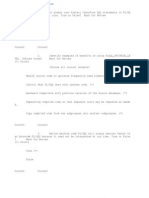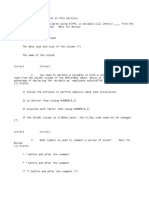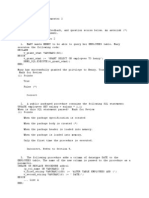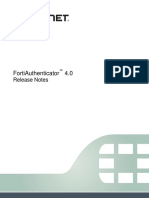Section 8
Section 8
Uploaded by
SebassssdCopyright:
Available Formats
Section 8
Section 8
Uploaded by
SebassssdOriginal Description:
Copyright
Available Formats
Share this document
Did you find this document useful?
Is this content inappropriate?
Copyright:
Available Formats
Section 8
Section 8
Uploaded by
SebassssdCopyright:
Available Formats
Test: Quiz: Creating Procedures Review your answers, feedback, and question scores below.
An asterisk (*) indicates a correct answer. Section 1 (Answer all questions in this section) 1. Which of the following are characteristics of anonymous PL/SQL blocks but not PL/SQL subprograms? (Choose three.) (Choose all correct answers) Can take parameters Are stored in the database Can begin with the keyword DECLARE (*) Are unnamed (*) Are compiled every time they are executed (*) Correct 2. Which of the following keywords MUST be included in every PL/SQL procedure definition? (Choose two.) (Choose all correct answers) BEGIN (*) REPLACE EXCEPTION DECLARE END (*) Correct 3. PL/SQL subprograms, unlike anonymous blocks, are compiled each time they are executed. True or False? True False (*) Correct 4. Which of the following are benefits of using PL/SQL subprograms rather than anonymous blocks? (Choose three.) (Choose all correct answers) Better data security (*) Code reuse (*) Stored externally Easier code maintenance (*) Mark for Review (1) Points Mark for Review (1) Points Mark for Review (1) Points Mark for Review (1) Points
Do not need to define exceptions Correct 5. A stored procedure add_dept may be invoked by the following command in Application Express. True or False? BEGIN add_dept; END; True (*) False Correct 6. The following are the steps involved in creating, and later modifying and re-creating, a PL/SQL procedure in Application Express. Which step is missing? Mark for Review (1) Points Mark for Review (1) Points
1.
2. 3. 4. 5.
Type the procedure code in the SQL Commands window Click on the "Save" button and save the procedure code Retrieve the saved code from "Saved SQL" in SQL Commands Modify the code in the SQL Commands window Execute the code to re-create the procedure
Enter parameters and data type Exe ute the procedure from USRE_SOURCE data dictionary view Execute the code to create the procedure (*) Invoke the procedure from an anonymous block Correct 7. Subprograms and anonymous blocks can be called by other applications. True or False? True False (*) Correct 8. Procedures are generally used to perform what? Mark for Review (1) Points Mark for Review (1) Points
A SELECT statement An action (*) A return of values All of the above None of the above Correct
9. When modifying procedure code, the procedure code statement must be re-executed to validate and store it in the database. True or False? True False (*) Correct 10. A programmer wants to create a PL/SQL procedure named MY_PROC. What will happen when the following code is executed? CREATE OR REPLACE PROCEDURE my_proc IS v_empid employees.empid%TYPE; BEGIN SELECT employee_id INTO v_empid FROM employees WHERE region_id = 999; DBMS_OUTPUT.PUT_LINE('The salary is: ' || v_salary); The statement will raise a NO_DATA_FOUND exception because region_id 999 does not exist. The statement will fail because the last line of code should be END my_proc; (*) The statement will fail because you cannot declare variables such as v_empid inside a procedure. Correct 11. A nested subprogram can be called from the main procedure or from the calling environment. True or False? True False (*) Correct 12. Why will the following procedure fail? CREATE OR REPLACE PROCEDURE mainproc ... IS PROCEDURE subproc (...) IS BEGIN ... BEGIN ... subproc (...); ... END; Procedure main proc must use the keyword AS not IS Procedure mainproc does not need the keyword BEGIN Procedure subproc does not need the keyword BEGIN Procedure subproc does not have an END; statement (*) Correct
Mark for Review (1) Points
Mark for Review (1) Points
Mark for Review (1) Points
Mark for Review (1) Points
13. A stored PL/SQL procedure can be invoked from which of the following?
1.
2. 3. 4.
A PL/SQL anonymous block A calling application A SELECT statement Another PL/SQL procedure
Mark for Review (1) Points
A only A and B A and C A, B and D (*) B and C Correct Test: Quiz: Using Parameters in Procedures Review your answers, feedback, and question scores below. An asterisk (*) indicates a correct answer. Section 1 (Answer all questions in this section) 1. A procedure has been created as: CREATE PROCEDURE myproc (p_left NUMBER, p_right NUMBER) IS BEGIN .... You want to call the procedure from an anonymous block. Which of the following calls is valid? myproc(p_left, p_right); myproc(v_left, v_right); myproc(v_left, 30); All of the above. (*) Incorrect. Refer to Section 8 Lesson 2. 2. Which of the following can be used as an argument for a procedure parameter? Mark for Review (1) Points Mark for Review (1) Points
The name of a variable. A literal value. An expression. All of the above. (*) None of the above. Correct
3. What is the correct syntax to create procedure MYPROC that accepts two number parameters X and Y? CREATE PROCEDURE myproc (x NUMBER, y NUMBER) IS ... (*) CREATE PROCEDURE (x NUMBER, y NUMBER) myproc IS ... CREATE PROCEDURE myproc IS (x NUMBER, y NUMBER) ... CREATE PROCEDURE IS myproc (x NUMBER, y NUMBER) Correct 4. What is the purpose of using parameters with stored procedures?
Mark for Review (1) Points
Mark for Review (1) Points
They prevent the procedure from modifying data in the database. They allow values to be passed between the calling environment and the procedure. (*) They count the number of exceptions raised by the procedure. They speed up the execution of the procedure. Correct 5. Which of the following best describes the difference between a parameter and an argument? They are both names of variables. A parameter is passed into the procedure, while an argument is passed out of the procedure A parameter is the name of a variable, while an argument is the datatype of that variable A parameter is the name of a variable that is passed into or out of a procedure, while an argument is the value of that variable (*) There is no difference, parameters and arguments are the same thing Correct Test: Quiz: Passing Parameters Review your answers, feedback, and question scores below. An asterisk (*) indicates a correct answer. Section 1 (Answer all questions in this section) 1. Three IN parameters for procedure ADD_EMPLOYEE are defined as: (p_name VARCHAR2 , p_salary NUMBER := 1000, p_hired DATE DEFAULT SYSDATE) The procedure is invoked by: add_employee('Jones'); What is the value of P_SALARY when the procedure starts to execute? NULL Mark for Review (1) Points Mark for Review (1) Points
1000 (*) The procedure will not compile because P_SALARY should have been coded as DEFAULT 1000 The call will fail because P_SALARY is a required parameter Correct 2. When creating a procedure, where in the code must the parameters be listed? Mark for Review (1) Points
After the procedure name. (*) After the keyword IS or AS. Before the procedure name. After the keyword PROCEDURE. Correct 3. A procedure is invoked by this command: myproc('Smith',salary=>5000); What is the method of passing parameters used here? Positional Named A combination of positional and named (*) None of the above Correct 4. Procedure NUMPROC has been created as: CREATE PROCEDURE numproc (x NUMBER, y NUMBER := 100, z NUMBER) IS BEGIN .... You want to call the procedure, passing arguments of 10 for X and 20 for Z. Which one of the following calls is correct? numproc(10,,20); numproc(x=10,z=20); numproc(10,z=>20); (*) numproc(x=>10,20); Correct 5. Which of the following statements about IN OUT parameters is true? (Choose two.) Mark for Review (1) Points Mark for Review (1) Points Mark for Review (1) Points
(Choose all correct answers)
The data type for the parameter must be VARCHAR2. The parameter value passed into the subprogram is always returned unchanged to the calling environment. The parameter value can be returned as the original unchanged value. (*) The parameter value can be returned as a new value that is set within the procedure. (*) Correct 6. A procedure is invoked by this command: myproc('Smith',100,5000); What is the method of passing parameters used here? Positional (*) Named A combination of positional and named. None of the above Correct 7. What are the three parameter modes for procedures? Mark for Review (1) Points Mark for Review (1) Points
IN, OUT, IN OUT (*) R(ead), W(rite), A(ppend) CONSTANT, VARIABLE, DEFAULT COPY, NOCOPY, REF Correct 8. What will happen when the following procedure is called as format_phone (8005551234)? CREATE OR REPLACE PROCEDURE format_phone (p_phone_no IN OUT VARCHAR2) IS BEGIN p_phone_no := SUBSTR(p_phone_no,1,3) || '.' || SUBSTR(p_phone_no,4,3) || '.' || SUBSTR(p_phone_no,7); END format_phone; The phone number 800.555.1234 is printed to the screen. The phone number (800) 555-1234 is printed to the screen. The phone number 800.555.1234 is placed into the p_phone_no variable. (*) The procedure does not execute because the input variable is not properly declared. Correct Mark for Review (1) Points
9. If you don't specify a mode for a parameter, what is the default mode?
Mark for Review (1) Points
OUT IN (*) COPY DEFAULT R(ead) Correct 10. Which kind of parameters cannot have a DEFAULT value? Mark for Review (1) Points
OUT (*) IN CONSTANT R(ead) W(rite) Correct 11. The following procedure has been created: CREATE OR REPLACE PROCEDURE myproc (p_p1 NUMBER, p_p2 VARCHAR2) IS BEGIN ... Which one of the following calls to the procedure will NOT work? myproc(80, 'Smith'); myproc(p_p1 => 80, 'Smith'); (*) myproc(80, p_p2 => 'Smith'); myproc(p_p1 => 80, p_p2 => 'Smith'); Correct Mark for Review (1) Points
You might also like
- Midterm Part 2Document19 pagesMidterm Part 2alexpuiuNo ratings yet
- CGR To Step Conversion ProcessDocument9 pagesCGR To Step Conversion Processraman_gomathamNo ratings yet
- Glimmertech RequirementsDocument19 pagesGlimmertech Requirementsspy netNo ratings yet
- Final2 Sem1Document21 pagesFinal2 Sem1Ioana Toader0% (1)
- FinalDocument85 pagesFinalMohanned Ali0% (1)
- Final ExamDocument14 pagesFinal Exama23mer14390% (3)
- Semester 1 Final Exam Oracle PL SQL 3Document24 pagesSemester 1 Final Exam Oracle PL SQL 3Game GMNo ratings yet
- Semester 1 - Final PDFDocument12 pagesSemester 1 - Final PDFRaduľkoMiruľkinVandžuraNo ratings yet
- Semester 1 Final Exam Oracle PL SQLDocument23 pagesSemester 1 Final Exam Oracle PL SQLCatalina Achim67% (9)
- Semester 2 Final Exam PL SQLDocument10 pagesSemester 2 Final Exam PL SQLCatalina AchimNo ratings yet
- PL/SQL Raspunsuri Test FinalDocument27 pagesPL/SQL Raspunsuri Test FinalCristina Dinu50% (2)
- Chapter 8Document6 pagesChapter 8Fajar PamungkasNo ratings yet
- PLSQL Oracle Mid Term Exam Semester 1 Part 1Document21 pagesPLSQL Oracle Mid Term Exam Semester 1 Part 1draufyNo ratings yet
- Section 8Document8 pagesSection 8Ovie WidiyastutiNo ratings yet
- PLSQLDocument49 pagesPLSQLjane02743% (7)
- ORACLE PLSQL Mid Term Part 1 SOLUTIONSDocument17 pagesORACLE PLSQL Mid Term Part 1 SOLUTIONScrispy_joyNo ratings yet
- PLSQL Feedback Final Exam Semister 1Document327 pagesPLSQL Feedback Final Exam Semister 1USNY_BTHSA_PLSQL01No ratings yet
- Semester 1 Final Exam Oracle PL SQL 2 PDFDocument23 pagesSemester 1 Final Exam Oracle PL SQL 2 PDFAziz FikriNo ratings yet
- Semester 1 Mid Term Exam - Part 1Document20 pagesSemester 1 Mid Term Exam - Part 1Catalina AchimNo ratings yet
- Section 4Document14 pagesSection 4SebassssdNo ratings yet
- Section 12 Improving PL-SQL PerformanceDocument3 pagesSection 12 Improving PL-SQL PerformancescribdfatihNo ratings yet
- Final Exam 2 PLSQLDocument10 pagesFinal Exam 2 PLSQLjane027No ratings yet
- Pls QL Section 12Document10 pagesPls QL Section 12scribdfatih100% (2)
- Semester 1 FinalDocument29 pagesSemester 1 FinalBudi NugrohoNo ratings yet
- Quiz DP 17Document4 pagesQuiz DP 17Panda DamanikNo ratings yet
- 005 - Semester 2 Final ExamDocument9 pages005 - Semester 2 Final ExamDaniel SereaNo ratings yet
- PLSQL Quiz 1 - 3Document1 pagePLSQL Quiz 1 - 3Alvin Giovanni MingguwNo ratings yet
- OracleDocument15 pagesOracleBomboana Cu IndulcitorNo ratings yet
- Sem 1 MidtermDocument24 pagesSem 1 MidtermDorin ChioibasNo ratings yet
- Final Exam Semester 1Document21 pagesFinal Exam Semester 1Alexandra PaparuscaNo ratings yet
- Cursor PDFDocument104 pagesCursor PDFMerry SinhaNo ratings yet
- Oracle Placement Sample Paper 5Document16 pagesOracle Placement Sample Paper 5Naveen PalNo ratings yet
- Midterm Sem II EuDocument13 pagesMidterm Sem II EuIoana Loredana TeodorescuNo ratings yet
- Semester 2 Final Exam PL SQLDocument9 pagesSemester 2 Final Exam PL SQLCatalina Achim100% (1)
- Plsqlparti 1Document19 pagesPlsqlparti 1RC LuckyNo ratings yet
- Final 2 PLSQLDocument16 pagesFinal 2 PLSQLBadri Mahmoud AliNo ratings yet
- Quiz 5Document13 pagesQuiz 5AndriyNo ratings yet
- Quiz 2 PL - SQLDocument6 pagesQuiz 2 PL - SQLJajang Mochamad MimbarNo ratings yet
- Semester 2 Final Exam PL SQL 2Document10 pagesSemester 2 Final Exam PL SQL 2agulfam5542No ratings yet
- Section 10Document43 pagesSection 10lemi teknik0% (2)
- Final Exam1Document151 pagesFinal Exam1Radut MadalinNo ratings yet
- Section 7Document11 pagesSection 7SebassssdNo ratings yet
- Quiz 5Document7 pagesQuiz 5Emanuel G.0% (1)
- Final Exam JavaDocument13 pagesFinal Exam JavaYulia KendengisNo ratings yet
- Dokumen - Tips Quiz-S8Document12 pagesDokumen - Tips Quiz-S8Ivan YapputraNo ratings yet
- Quiz s8Document10 pagesQuiz s8a23mer1439No ratings yet
- Section 8 5659af320768bDocument11 pagesSection 8 5659af320768berwinNo ratings yet
- Section 8 QuizDocument8 pagesSection 8 QuizDorin Chioibas100% (1)
- Quiz 8Document12 pagesQuiz 8AndriyNo ratings yet
- Creating ProceduresDocument5 pagesCreating ProceduresCatalina AchimNo ratings yet
- Passing ParametersDocument5 pagesPassing ParametersCatalina AchimNo ratings yet
- Final I 1Document3 pagesFinal I 1Fatih ÜçlerNo ratings yet
- Final Exam Semester 1Document19 pagesFinal Exam Semester 1Madalina Marcu100% (1)
- Semester 1 Final Exam Oracle PL SQLDocument24 pagesSemester 1 Final Exam Oracle PL SQLCatalina Achim75% (8)
- Quiz s9Document15 pagesQuiz s9giggl123No ratings yet
- Fin Ex s1Document22 pagesFin Ex s1Marin FlorinaNo ratings yet
- Final2 Sem1Document21 pagesFinal2 Sem1Beckhs BksNo ratings yet
- FinalDocument84 pagesFinalMohanned AliNo ratings yet
- Oracle Practice QuizDocument18 pagesOracle Practice QuizblakeNo ratings yet
- PLSQL Midterm2Document67 pagesPLSQL Midterm2BarkaMNo ratings yet
- ORACLE PLSQL Midterm SEM 2 3 SOLUTIONSDocument19 pagesORACLE PLSQL Midterm SEM 2 3 SOLUTIONScrispy_joyNo ratings yet
- Section 9Document14 pagesSection 9Sebassssd0% (2)
- Section 9Document14 pagesSection 9Sebassssd0% (2)
- Section 7Document11 pagesSection 7SebassssdNo ratings yet
- Section 5Document16 pagesSection 5Sebassssd33% (3)
- Section 6Document3 pagesSection 6Sebassssd0% (2)
- Section 4Document14 pagesSection 4SebassssdNo ratings yet
- Section 2Document6 pagesSection 2Sebassssd100% (1)
- Section 3Document8 pagesSection 3SebassssdNo ratings yet
- FAFL Notes (2010) (SJBIT)Document124 pagesFAFL Notes (2010) (SJBIT)maruthinmdcNo ratings yet
- Complete SasDocument284 pagesComplete SasNaresh Kumar Gamidi100% (1)
- Log in or Sign Up in C++Document3 pagesLog in or Sign Up in C++Muhammad Akif NaeemNo ratings yet
- LINQ To SQLDocument107 pagesLINQ To SQLAntonio LimaNo ratings yet
- Visual Basic FileDocument17 pagesVisual Basic FileAmit CoolNo ratings yet
- Ionic 4 Forms Tutorial - Login & Register UI Example With Theming - TechiediariesDocument15 pagesIonic 4 Forms Tutorial - Login & Register UI Example With Theming - TechiediariesEstebanRodriguezNo ratings yet
- Normalization of Database: First Normal Form (1NF)Document10 pagesNormalization of Database: First Normal Form (1NF)Piyush JainNo ratings yet
- 8255Document84 pages8255spowna0% (1)
- 11 Loadcell AccuracyDocument32 pages11 Loadcell AccuracyCecep AtmegaNo ratings yet
- FortiAuthenticator 4.0 Release NotesDocument25 pagesFortiAuthenticator 4.0 Release NotesAndrew WebbNo ratings yet
- Screenshots Itil Process Map Visio PDFDocument16 pagesScreenshots Itil Process Map Visio PDFspamdamanNo ratings yet
- 2802ICT Programming Assignment 2Document6 pages2802ICT Programming Assignment 2Anonymous 07GrYB0sNNo ratings yet
- Overview of Android Programming: March 3, 2012Document24 pagesOverview of Android Programming: March 3, 2012TheoryOf NegativityNo ratings yet
- Fujitsu CGI CourierDocument2 pagesFujitsu CGI CourierFujitsu Semiconductor EuropeNo ratings yet
- UserGuide PDFDocument270 pagesUserGuide PDFJorge MarquesNo ratings yet
- Isod Relnotes PDFDocument30 pagesIsod Relnotes PDFrlnjay2003No ratings yet
- How To Export Logs To Arcsight Siem DevicesDocument3 pagesHow To Export Logs To Arcsight Siem Devicesalesia1990No ratings yet
- DBMS Lab ManualDocument199 pagesDBMS Lab ManualMoulika Chowdary100% (1)
- Fusion 980 PDFDocument6 pagesFusion 980 PDFAlberto LandaNo ratings yet
- What Is Vulnerability ManagementDocument2 pagesWhat Is Vulnerability Managementeddystan1No ratings yet
- Integration Documentation: Ecc - Hci - C4CDocument7 pagesIntegration Documentation: Ecc - Hci - C4CRobbin PintoNo ratings yet
- Drag and Drop in Visual BasicDocument4 pagesDrag and Drop in Visual Basicjmm744No ratings yet
- Guwada InternshipDocument27 pagesGuwada InternshipgirumNo ratings yet
- Database Systems I: Database Design, ER ModellingDocument54 pagesDatabase Systems I: Database Design, ER ModellingdonkeybrotherNo ratings yet
- Mathematics 11: Presented By: Amy B. BandiwanDocument8 pagesMathematics 11: Presented By: Amy B. BandiwanYowdead is the name nameNo ratings yet
- Network Basics: by Muhammad Arslan Farooq Mba-Itm (Iiui)Document44 pagesNetwork Basics: by Muhammad Arslan Farooq Mba-Itm (Iiui)Hadia Sundas100% (1)
- Intro To IEEE 1149.1 Boundary-Scan (JTAG)Document50 pagesIntro To IEEE 1149.1 Boundary-Scan (JTAG)Aji ThomasNo ratings yet
- Swift Developers BookDocument56 pagesSwift Developers Booksharmabastola100% (1)





























































































